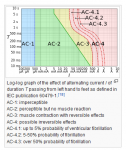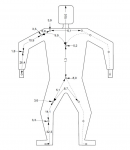ptonsparky
Tom
- Occupation
- EC - retired
How does the presence or lack of an EG affect the values of a L-L short circuit?From a human protection perspective, yes.
How does the presence or lack of an EG affect the values of a L-L short circuit?From a human protection perspective, yes.
The only downsides are that some time later, another person checks and says "Why so low?", investigates, and curses the original installer for doing such a bad job; or that the client wants to install a specific voltage device and doesn't understand why they can't or they need to add an extra device to get the right voltage.
If nothing else, there needs to be some good documentation at the far end describing how it's being fed.
How does the presence or lack of an EG affect the values of a L-L short circuit?
It does not.
Good. We agree.
I'd be curious to know if the equipment being fed is all multi-voltage capable. Sometimes these types of equipment can be fed any 50-60HZ voltage between 120 and 277 with no ill effects. Voltage drop is a FPN in the code anyway...so 5% is not a hard requirement....just a suggestion. So if the load is, say, all electronic equipment and LED lighting with the multi-volt type power requirements...then a 20-30% drop may still get the job done. Am I missing something here?
20-30% drop would violate 110.10 as the OCPD would not function.No, you’re not.
Why won't it? My Fault current calculator indicates 50 amps will flow at 6500 feet. That is more than enough to open a 20 amp fuse. At that distance how fast does it need to open on a short circuit? Nothing will be damaged by the 50 amps. The damage was already done when the SC occured. Granted I did use line to line and not L-EG.. That will take a longer depending on the fuse type but still no damage done20-30% drop would violate 110.10 as the OCPD would not function.
Aren't fuses standard?I would revise tortuga's statement to say that if you were to design your circuit to function with a 20-30% voltage drop, you would need to use non-standard ($$$$) OCPD for proper function.
There is always a way...but reducing voltage drop is probably the simplest.
-Jon
This is just academic discussion at this point with the 6500 FT and 1kw load as givens.Railroads have many signals and shacks were there is no commercial power, typically some kind of propane, so that may be an option
Also there are some good options on fuel cells, and that technology is mature, can integrate with solar. I looked into fuel cells there are some systems in a box, so to speak.
ohh right I did not look at a 20A breaker I was figuring a 60 I think.Why won't it? My Fault current calculator indicates 50 amps will flow at 6500 feet. That is more than enough to open a 20 amp fuse. At that distance how fast does it need to open on a short circuit? Nothing will be damaged by the 50 amps. The damage was already done when the SC occured. Granted I did use line to line and not L-EG.. That will take a longer depending on the fuse type but still no damage done
Aren't fuses standard?
I looked at various curves for fuses. Range from well ok they will work to the water in the conduit won’t freeze.This is just academic discussion at this point with the 6500 FT and 1kw load as givens.
ohh right I did not look at a 20A breaker I was figuring a 60 I think.
It still would be interesting to look into the trip time/current curve of say a Siemens or Eaton bolt on 480V breaker.
Why won't it? My Fault current calculator indicates 50 amps will flow at 6500 feet. That is more than enough to open a 20 amp fuse. At that distance how fast does it need to open on a short circuit? Nothing will be damaged by the 50 amps. The damage was already done when the SC occured. Granted I did use line to line and not L-EG.. That will take a longer depending on the fuse type but still no damage done


Well other than that guy with a bad heart...or soon to have one, if it’s a L-EG fault.Perhaps this?
View attachment 2551908
View attachment 2551909
Typically 0.4 seconds for over 120 volts to ground, 0.8 seconds 120 and under.
Well other than that guy with a bad heart...or soon to have one, if it’s a L-EG fault.
